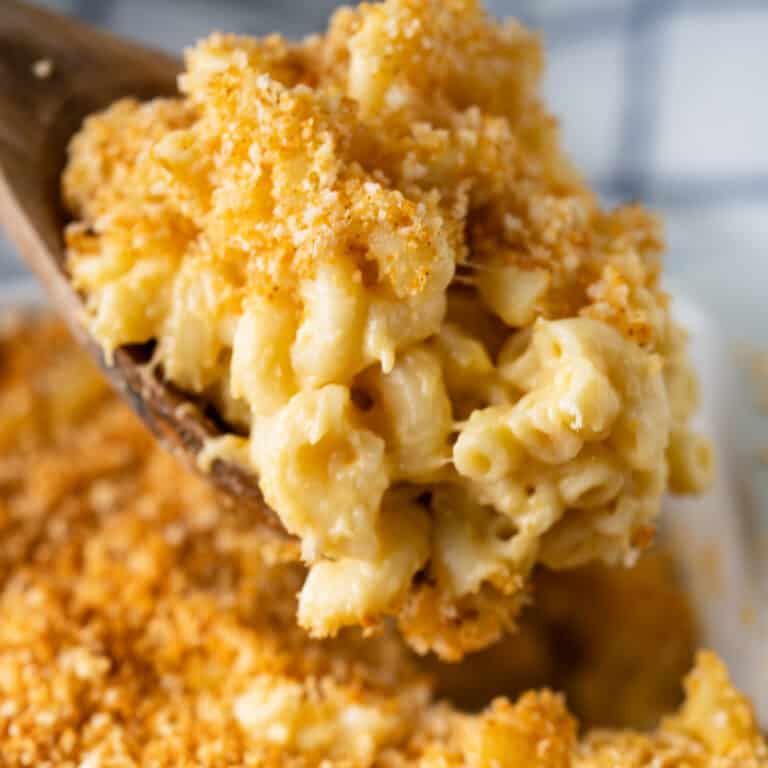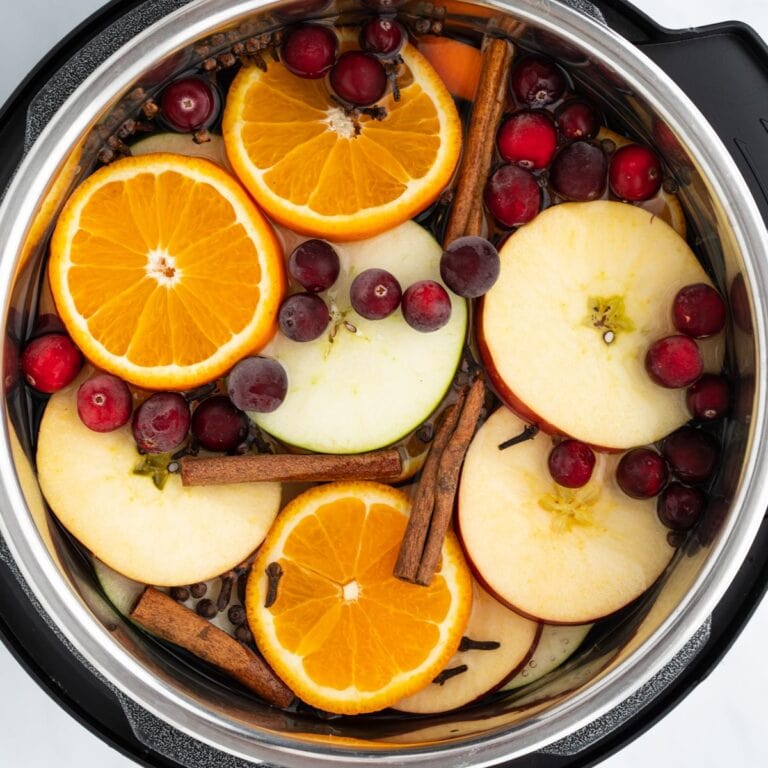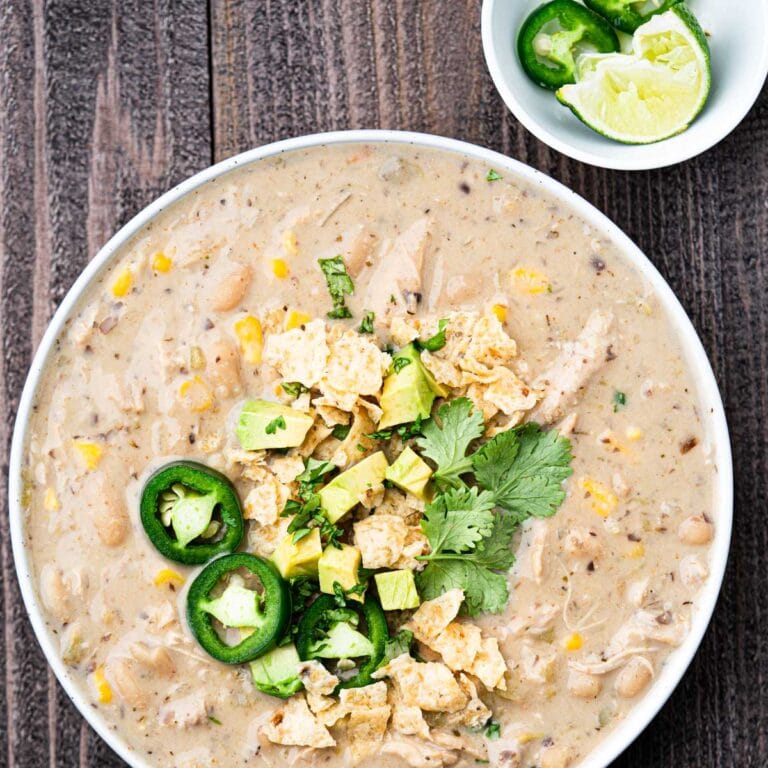Boston Roll
This Boston roll is the perfect blend of succulent shrimp, creamy avocado, and crisp cucumber all wrapped in seasoned rice and nori. With a little prep and a whole lot of flavor, you’ll be enjoying this delicious sushi roll in less than 20 minutes.
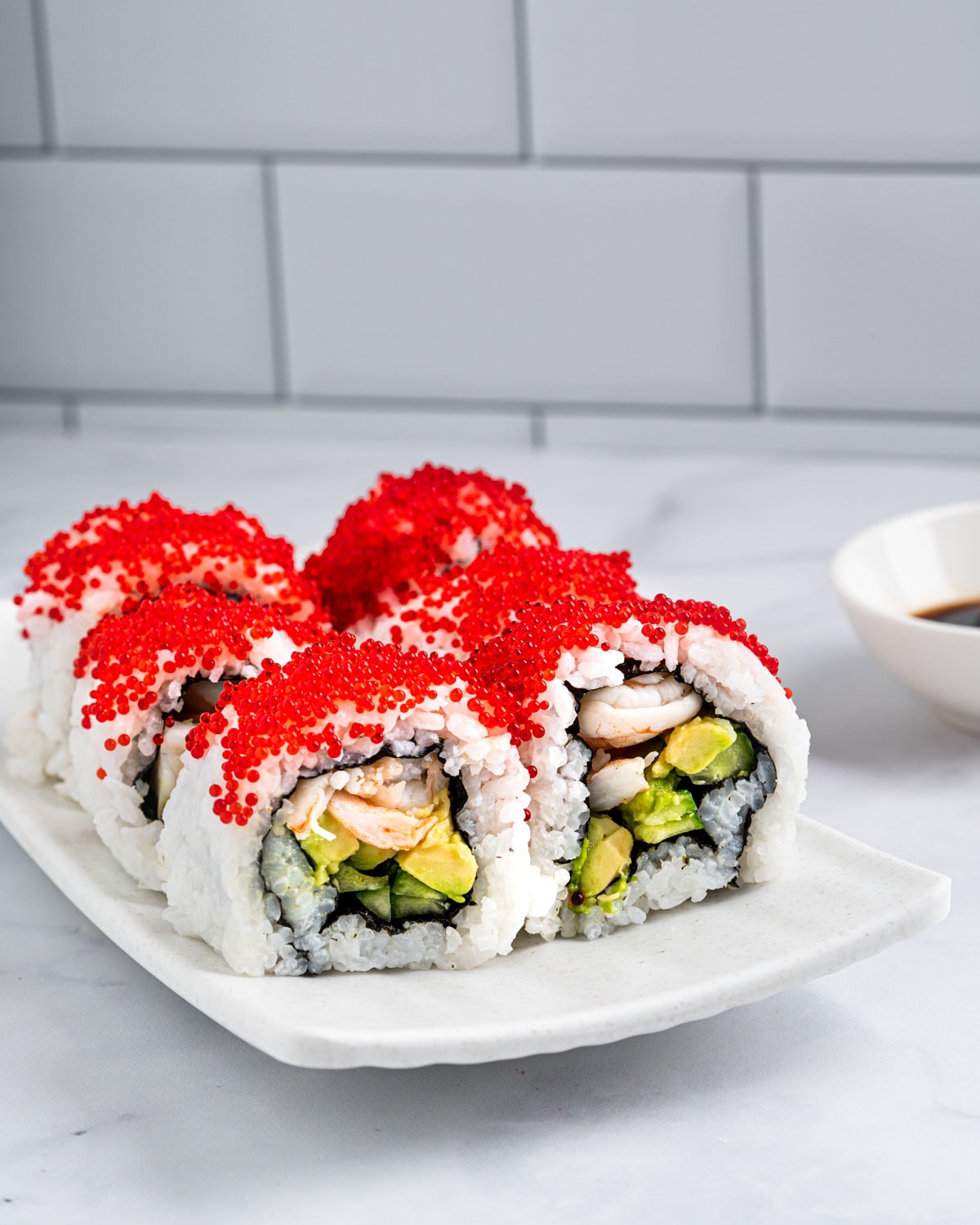
Usually, sushi can be enjoyed as an appetizer, snack, or part of a larger meal but this Boston Roll is substantial enough to be a light meal on its own. I love to eat these with a Oshinko Roll or two! The cooked shrimp, avocado, cucumber, rice, and seaweed offers a balanced blend of protein, healthy fats, and carbohydrates. It is a satisfying and flavorful option if you’re looking for a smaller meal or a snack-sized portion.
What is a Boston Roll?
A Boston roll is a type of sushi roll commonly found in Japanese restaurants, particularly in the United States. It is characterized by its combination of ingredients, typically including cooked shrimp, avocado, and cucumber. The roll is usually made by wrapping these ingredients in a sheet of nori (seaweed) and seasoned rice, and then cutting it into bite-sized pieces.
The Boston roll is unique in that it often features cooked seafood, such as poached or tempura shrimp, as opposed to the more traditional raw fish found in many other types of sushi rolls. The use of avocado and cucumber provides a refreshing and creamy texture, which complements the shrimp well. The roll is often served with soy sauce, wasabi, and pickled ginger on the side for dipping and added flavor.
It’s important to note that sushi styles and ingredients can vary from region to region and from one sushi chef to another. So, while the basic ingredients of a Boston roll remain fairly consistent, there might be slight variations in its preparation and presentation.
Why you’ll love this recipe
- Easy-to-Find Ingredients: The ingredients commonly used in a Boston roll, such as shrimp, avocado, and cucumber, are usually readily available in most grocery stores. This makes it convenient to gather the necessary components for making the roll at home.
- Kid-Friendly: The combination of familiar and approachable ingredients in a Boston roll, such as cooked shrimp and avocado, can make it appealing to children who might be hesitant to try more traditional sushi with raw fish. Its mild flavors and textures are often better suited for young palates.
- Ease of Preparation: Creating a Boston roll is relatively straightforward, making it a great option for both beginner and intermediate home cooks. The absence of raw fish simplifies the process, and the assembly can be a fun activity for families or individuals looking to experiment with sushi-making.
- A Balanced Flavor Profile: The ingredients in a Boston roll provide a well-balanced flavor profile. The sweetness of the shrimp, the richness of the avocado, and the freshness of the cucumber combine to create a taste that is appealing to many people.
- Healthier Option: While sushi rolls can vary in terms of healthiness, a Boston roll’s inclusion of vegetables like cucumber and avocado can contribute to a relatively balanced and nutritious meal.
- Adaptability: The Boston roll can easily be adapted and customized to personal tastes. You can experiment with additional ingredients or variations to fit your family’s preferences.
Kitchen Tools
Ingredients and Substitutions

- Nori (Seaweed Sheets): Nori provides the outer layer of the roll, adding umami flavor, texture, and color. Find it in Asian grocery stores or online.
- Sushi Rice: Sushi rice is short-grain Japanese rice. It’s sticky, allowing the roll to hold together. Available in most grocery stores.
- Rice Vinegar: Rice vinegar flavors the sushi rice and gives it a slightly tangy taste. Substitutes: White wine vinegar or apple cider vinegar.
- Sugar: Sugar balances the vinegar’s acidity in the rice.
- Salt: Salt enhances the overall flavor of the rice.
- Shrimp: Succulent shrimp adds a rich, slightly sweet flavor and tender texture to the roll, complementing other ingredients. For convenience, opt for peeled, and deveined shrimp.
- Cucumber: Cucumber adds a refreshing crunch and balances the flavors.
- Avocado: Avocado brings creaminess and a mild taste to the roll. Substitutes: cream cheese.
- Fish Roe (optional): Tobiko (flying fish roe) is a popular choice. It comes in vibrant colors like orange, red, and black. Its small, crunchy texture and mild briny flavor complement the other ingredients, providing a burst of umami. Tobiko roe can be found in specialty Asian grocery stores, seafood markets, or online. If unavailable, other roe options like masago (capelin roe) can also be used.
- Optional For Serving: soy sauce, wasabi, and pickled ginger.
- Water: Water is used for moistening hands and knife while handling sticky rice.
How to make it
Step One: Prepare Sushi Rice. Rinse sushi rice under cold water until water runs clear. Cook rice according to package instructions. While hot, mix with rice vinegar, sugar, and salt. Let it cool to room temperature.
Step Two: Prep Ingredients. Bring a pot of seasoned water to a gentle simmer, add peeled and deveined shrimp, and cook for 2-3 minutes until they turn pink and opaque. Peel and devein poached shrimp, cutting them in half lengthwise. Slice avocado and cucumber into thin strips.
Step Three: Set Up Rolling Station. Lay the bamboo mat on a clean surface. Place a sheet of plastic wrap on top to prevent sticking. Lay a nori sheet on the plastic wrap, shiny side down.
Step Four: Spread Sushi Rice. Moisten your hands with water to prevent sticking. Take a handful of sushi rice and gently spread it over the nori. Flip the rice-filled nori over.


Step Five: Add Fillings. Lay avocado, cucumber, and poached shrimp along the center of the rice. Be careful not to overfill.
Step Six: Roll the Sushi. Using the bamboo mat, start rolling the nori and fillings away from you. Use gentle pressure to shape the roll.
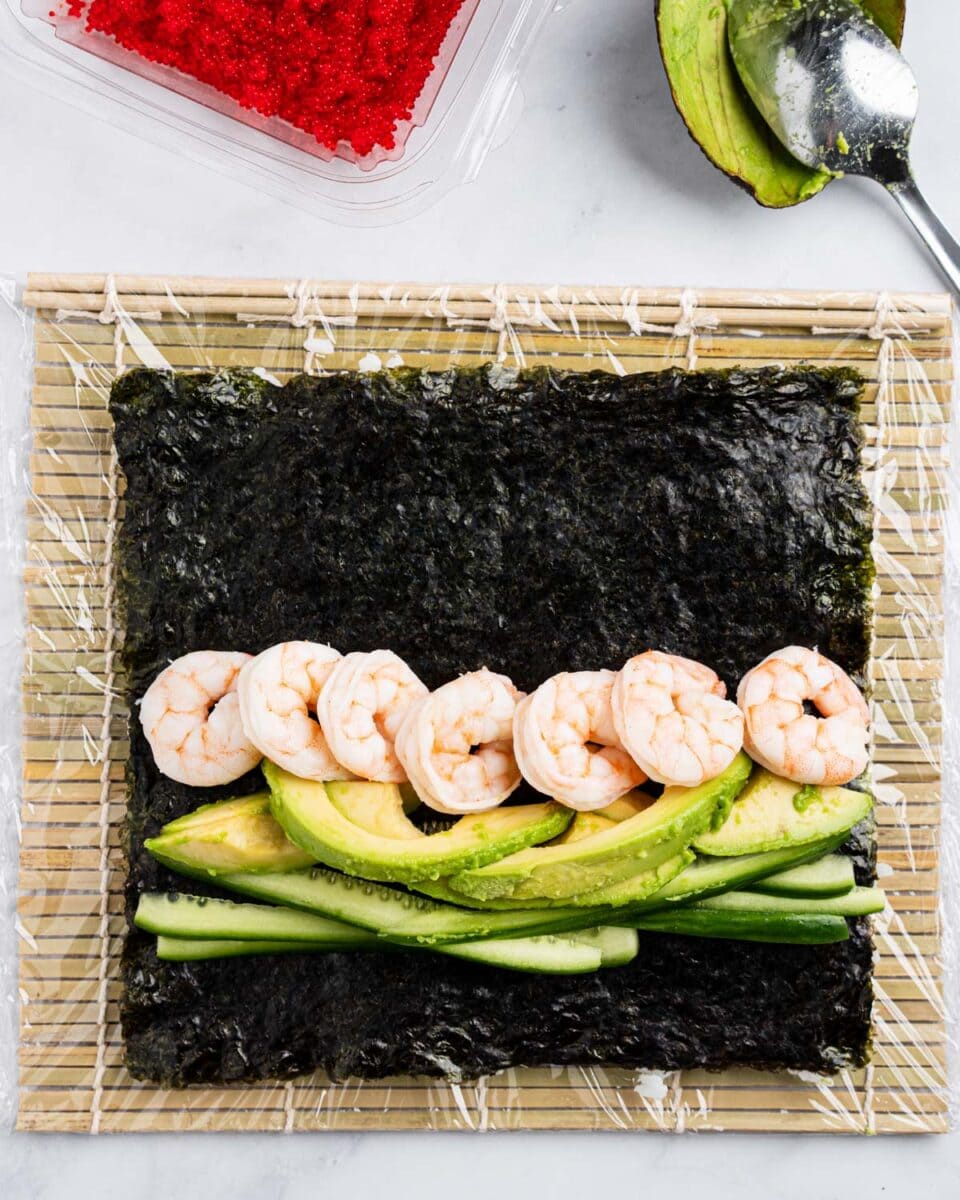
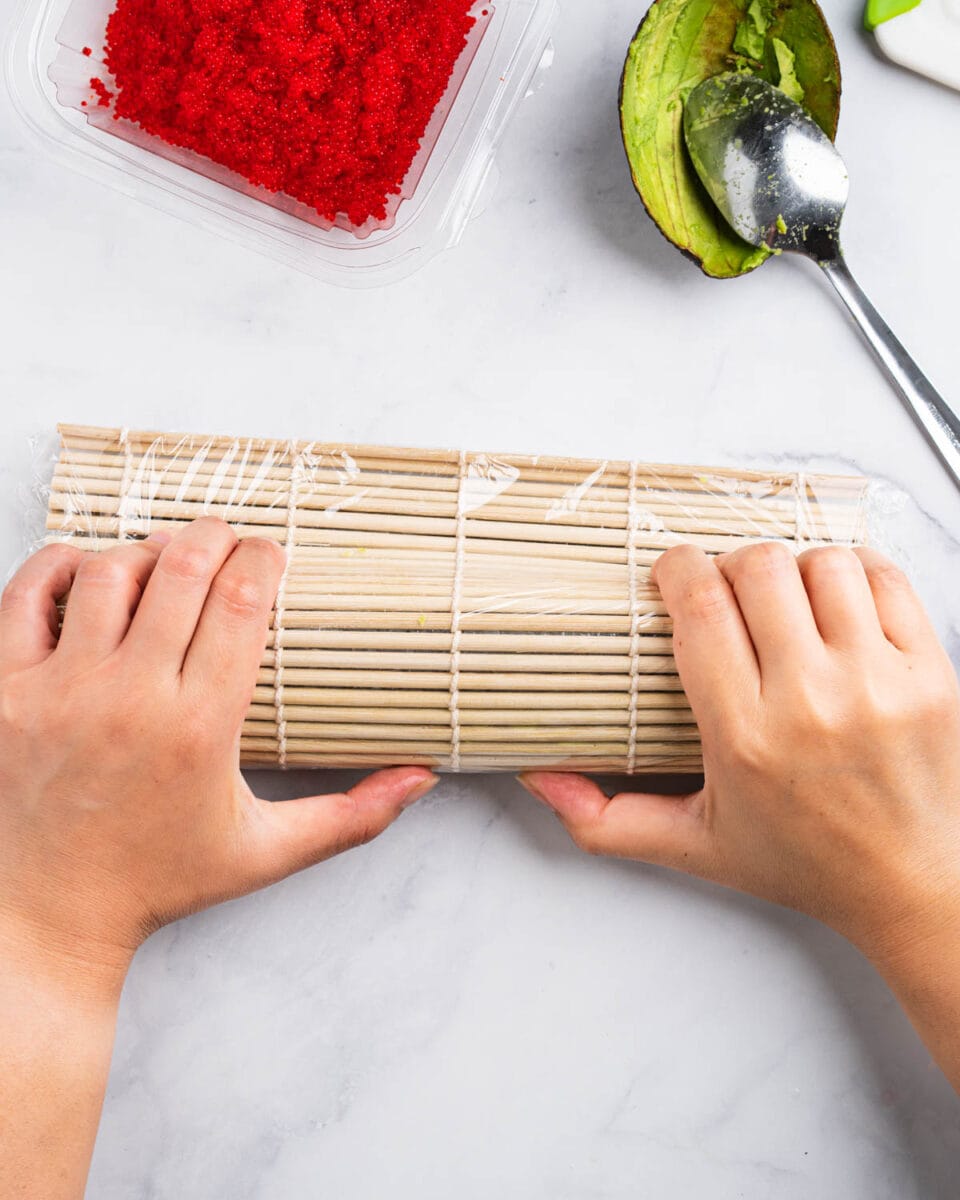
Step Seven: Cut the Roll. Use a sharp, wet knife to cut the roll into bite-sized pieces. Wet the knife between cuts to ensure clean edges.
Serve and Garnish: Arrange the Boston roll pieces on a serving plate. Sprinkle fish roe over the top for added flavor and visual appeal. Serve with soy sauce, wasabi, and pickled ginger.

Tips for making the best Boston Roll Sushi
- Thin and Even Rice Layer: Spread the sushi rice evenly over the nori sheet, leaving a small border at the top for sealing, to ensure a balanced roll.
- Filling Distribution: Arrange fillings—shrimp, avocado, and cucumber—along the center of the rice, distributing them evenly to achieve a consistent taste in each bite.
- Tight and Gentle Rolling: Roll the ingredients using a bamboo mat, applying gentle pressure to create a compact and uniform roll without squishing the fillings.
- Sharp Wet Knife: Use a sharp knife wetted between cuts to ensure clean slices without smashing the roll.
- Prevent Stickiness: Keep your hands moist when working with rice and nori to prevent sticking, and consider using plastic wrap on the bamboo mat to aid in rolling.
Frequently Asked Questions
A Boston roll is typically made up of cooked shrimp, avocado, cucumber, nori, and seasoned rice. Depending on personal preferences and regional variations, Boston rolls might be served with various dipping sauces or drizzles, such as soy sauce, eel sauce, or spicy mayo.
The Boston roll typically contains cooked shrimp, avocado, cucumber, nori (seaweed), and seasoned sushi rice. The shrimp is usually tempura-style or poached. The California roll consists of imitation crab (surimi), avocado, cucumber, and sometimes tobiko (fish roe), all wrapped in nori and sushi rice.
The Boston roll is a type of sushi roll that is commonly associated with Japanese cuisine, particularly in the context of sushi restaurants in the United States. Despite its name, the Boston Roll is not originally from Japan; it was likely created in the United States as a variation of traditional Japanese sushi rolls. The use of cooked shrimp and ingredients like avocado and cucumber is more in line with American tastes and preferences, making it a popular choice among sushi enthusiasts who may be new to raw fish or seeking different flavors and textures.
Yes, it is generally safe to eat a Boston Roll while pregnant. The ingredients in a Boston Roll, such as cooked shrimp, avocado, cucumber, and seaweed, are considered safe for consumption during pregnancy.
Remember that pregnancy experiences can vary, and what might be safe for one person might not be the same for another. If you have any concerns or doubts, it’s best to consult with your healthcare provider, who can provide personalized guidance based on your health status and needs.
A Boston roll is made with cooked or prepared ingredients and does not contain raw fish. It typically includes ingredients like poached shrimp, avocado, and cucumber. This makes it a great option for those who prefer cooked seafood or who are new to sushi. However, variations can exist, so it’s always a good idea to confirm the ingredients with the establishment or recipe you’re following.

How to store leftovers
Wrap Properly: Wrap the leftover Boston roll tightly in plastic wrap or aluminum foil. This helps prevent moisture loss and keeps the roll from drying out.
Refrigeration: Store the wrapped roll in the refrigerator and consume the leftovers within 1-2 days to ensure the best quality and safety. The longer sushi sits, the more its texture and flavor may deteriorate.
Avoid Freezing: Sushi rolls are not typically recommended for freezing. Freezing can alter the texture of the rice and the other components.
Reheating: Since the Boston roll contains ingredients like avocado and cucumber that don’t reheat well, it’s best to consume leftover sushi rolls cold. Reheating can negatively impact the texture and taste.
Quality Check: Before consuming the leftover Boston roll, inspect it for any signs of spoilage, such as off odors, strange colors, or sliminess. If you notice any of these, it’s best to discard the sushi.

Boston Roll
Equipment
Ingredients
For the sushi rice
- 2 cups cooked sushi rice
- 4 tablespoons rice vinegar
- 2 tablespoons sugar
- 1 teaspoon salt
For the Boston roll
- 12 large shrimps (steamed and sliced in half lengthwise)
- 2 nori seaweed sheets
- 1 avocado peeled, pitted and cut into thin slices
- 1 cucumber cut into sticks
- ⅓ cup tobiko or masago
For serving
- Japanese soy sauce
- wasabi paste
- sushi pickled ginger (Gari)
Instructions
- Prepare Sushi Rice. Rinse sushi rice under cold water until water runs clear. Cook rice according to package instructions. While hot, mix with rice vinegar, sugar, and salt. Let it cool to room temperature.
- Prep Ingredients. Bring a pot of seasoned water to a gentle simmer, add peeled and deveined shrimp, and cook for 2-3 minutes until they turn pink and opaque. Peel and devein poached shrimp, cutting them in half lengthwise. Slice avocado and cucumber into thin strips.
- Set Up Rolling Station. Lay the bamboo mat on a clean surface. Place a sheet of plastic wrap on top to prevent sticking. Lay a nori sheet on the plastic wrap, shiny side down.
- Spread Sushi Rice. Moisten your hands with water to prevent sticking. Take a handful of sushi rice and gently spread it over the nori. Flip the rice-filled nori over.
- Add Fillings. Lay avocado, cucumber, and poached shrimp along the center of the rice. Be careful not to overfill.
- Roll the Sushi. Using the bamboo mat, start rolling the nori and fillings away from you. Use gentle pressure to shape the roll.
- Step Seven: Cut the Roll. Use a sharp, wet knife to cut the roll into bite-sized pieces. Wet the knife between cuts to ensure clean edges.
- Serve and Garnish: Arrange the Boston roll pieces on a serving plate. Sprinkle fish roe over the top for added flavor and visual appeal. Serve with soy sauce, wasabi, and pickled ginger.
Notes
- Thin and Even Rice Layer: Spread the sushi rice evenly over the nori sheet, leaving a small border at the top for sealing, to ensure a balanced roll.
- Filling Distribution: Arrange fillings—shrimp, avocado, and cucumber—along the center of the rice, distributing them evenly to achieve a consistent taste in each bite.
- Tight and Gentle Rolling: Roll the ingredients using a bamboo mat, applying gentle pressure to create a compact and uniform roll without squishing the fillings.
- Sharp Wet Knife: Use a sharp knife wetted between cuts to ensure clean slices without smashing the roll.
- Prevent Stickiness: Keep your hands moist when working with rice and nori to prevent sticking, and consider using plastic wrap on the bamboo mat to aid in rolling.

